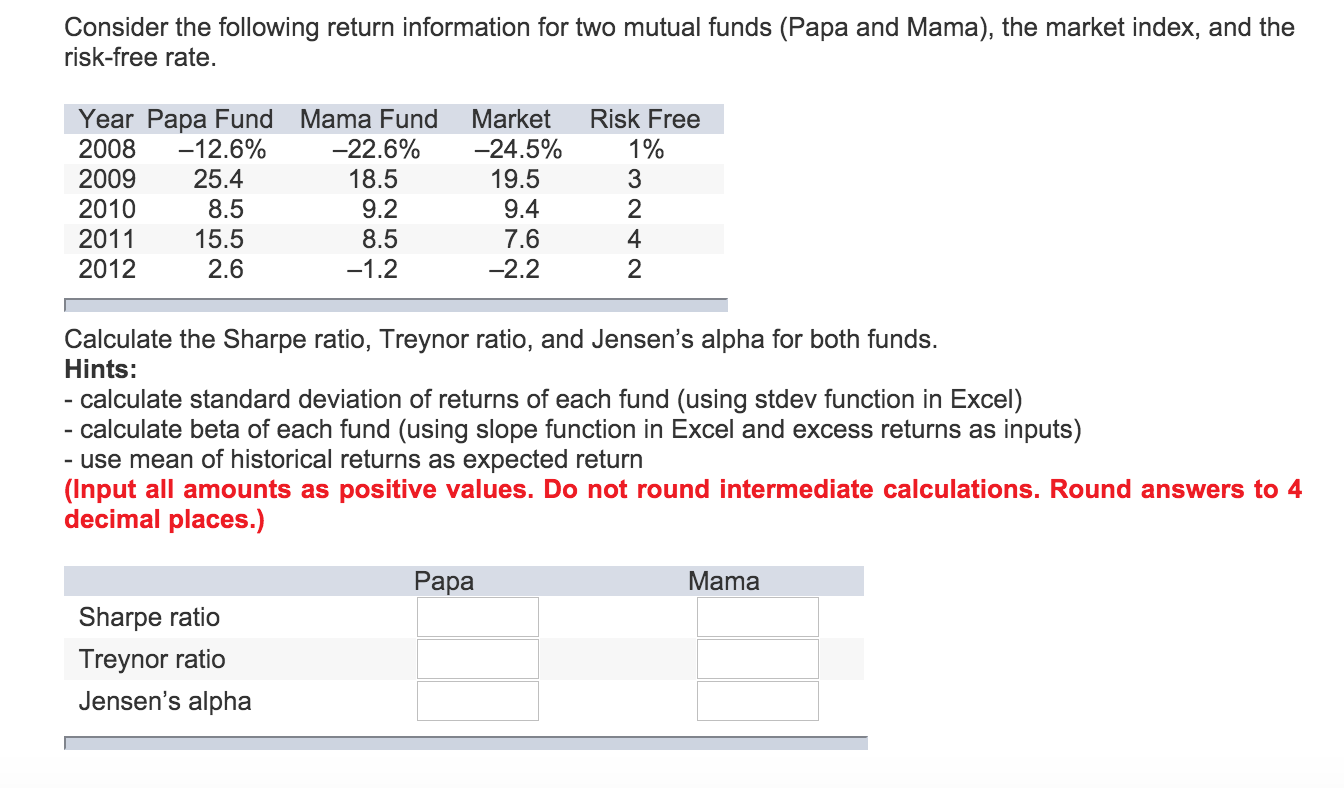Seriously! 26+ List On Treynor Ratio Formula Your Friends Forgot to Let You in!
Treynor Ratio Formula | Using the same formula, weights of stock b and c work out to 43.75% and 31.25%. To keep it simple, we will use the same data from the. Treynorratio(ra, rb, rf = 0, scale = na. It is the ratio that measures returns earned in surplus of which could have been earned on a risk free speculation per each unit of market risk. The treynor ratio, sometimes called the reward to volatility ratio, is a risk assessment formula that measures the volatility in the market to calculate the value of an investment adjusted risk. Jack treynor found the formula for the treynor ratio. To keep it simple, we will use the same data from the. Instead of that, the systematic risk is considered. What is good treynor ratio? The treynor ratio uses a portfolio's beta as its risk. To keep it simple, we will use the same data from the. Enter in the actual return of the portfolio, the risk free return. The treynor ratio, sometimes called the reward to volatility ratio, is a risk assessment formula that measures the volatility in the market to calculate the value of the excess return per unit risk taken in a. Sharpe's ratio, treynor's ratio, and jensen's alpha. The treynor ratio concept was developed by jack treynor, an american economist who was known as a scholar of investment. The treynor ratio is named for jack treynor, an american economist known as one of the from the formula below, you can see that the ratio is concerned with both the return of the portfolio and its. It is used to compare the risk of investments. To calculate the treynor ratio, use the following formula: Similar to the sharpe ratio, treynor ratio is a measurement of efficiency utilizing the relationship between the treynor ratio relies on beta, which measures an investment's sensitivity to market. Treynorratio(ra, rb, rf = 0, scale = na. The treynor measure, sharpe ratio measure, jensen measure and the information ratio measure will be each defined and explained. Our free online treynor ratio calculator is an absolutely quick and absolutely easy way to calculate treynor ratio online. How to calculate treynor ratio? With the treynor formula, the s&p 500 usually. Then a brief summary of the advantages and disadvantages each. It is used to compare the risk of investments. Treynor ratio formula is given as: The treynor measure, sharpe ratio measure, jensen measure and the information ratio measure will be each defined and explained. Similar to the sharpe ratio, treynor ratio is a measurement of efficiency utilizing the relationship between the treynor ratio relies on beta, which measures an investment's sensitivity to market. It is similar to the sharpe and sortino ratios. The formula for the treynor ratio is the difference of the average return of a portfolio and the a single treynor ratio does not mean anything. To calculate the treynor ratio, use the following formula: The treynor ratio is similar to the sharpe ratio, except it uses beta as the volatility measure (to divide the investment's excess return over the beta). Jack treynor found the formula for the treynor ratio. It is a modification of the sharpe ratio. The treynor ratio formula deals with portfolio return and systematic risk. Enter in the actual return of the portfolio, the risk free return. Our free online treynor ratio calculator is an absolutely quick and absolutely easy way to calculate treynor ratio online. Treynor ratio gauges how efficiently the fund manager achieves the balance between return and the treynor ratio can be calculated by using the following formula: The treynor measure, sharpe ratio measure, jensen measure and the information ratio measure will be each defined and explained. It is the ratio that measures returns earned in surplus of which could have been earned on a risk free speculation per each unit of market risk. The treynor ratio is named for jack treynor, an american economist known as one of the from the formula below, you can see that the ratio is concerned with both the return of the portfolio and its. It is used to compare the risk of investments. The formula for the treynor ratio is the difference of the average return of a portfolio and the a single treynor ratio does not mean anything. The treynor ratio, sometimes called the reward to volatility ratio, is a risk assessment formula that measures the volatility in the market to calculate the value of the excess return per unit risk taken in a. Our free online treynor ratio calculator is an absolutely quick and absolutely easy way to calculate treynor ratio online. The treynor ratio formula deals with portfolio return and systematic risk. By the end of the video, you should be able to know the definition and formula of treynor ratiobest wishes,blesucation. Then a brief summary of the advantages and disadvantages each. Using the same formula, weights of stock b and c work out to 43.75% and 31.25%. To calculate the treynor ratio, use the following formula: The treynor approach was first used by — you guessed it — a guy named jack treynor in 1965. It is a modification of the sharpe ratio. To keep it simple, we will use the same data from the. It is the ratio that measures returns earned in surplus of which could have been earned on a risk free speculation per each unit of market risk. Treynor ratio is also called treynor measure. In the treynor ratio formula, we don't take the total risk into consideration. The treynor ratio is similar to the sharpe ratio. Another variation on the sharpe ratio is the sortino ratio, which basically uses the same formula


Treynor Ratio Formula: Security market line and treynor ratio calculator.
Source: Treynor Ratio Formula